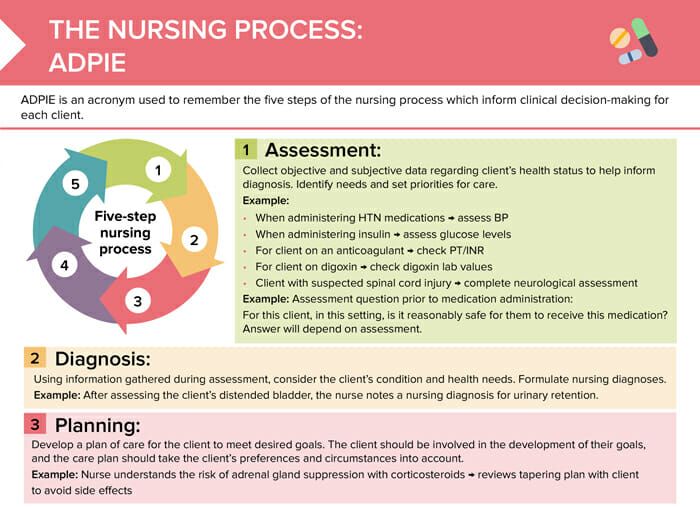Definition: What is the nursing process?
What does ADPIE stand for?
ADPIE is an acronym used to remember the five steps of the nursing process:
- Assessment
- Diagnosis
- Planning
- Implementation
- Evaluation
So, what is ADPIE (the nursing process)?
The nursing process is a systematic approach to patient/client care that follows five steps: Assessment, Diagnosis, Planning, Implementation, Evaluation.
This framework guides nurses in clinical decision-making, identifying patient needs, creating care plans, implementing interventions, and evaluating outcomes.
What are the steps of the nursing process?
The nursing process is cyclical, meaning you will cycle through the five steps again and again with your nursing clients.
#1 Assessment
Task: Collect objective and subjective data regarding client’s health status to help inform diagnosis. Identify needs and set priorities for care.
#2 Diagnosis
Task: Using information gathered during assessment, consider the client’s condition and health needs. Formulate nursing diagnosis/diagnoses.
#3 Planning
Task: Develop a plan of care for the client to meet desired goals. The client should be involved in the development of their goals, and the plan of care should take the client’s preferences and circumstances into account.
#4 Implementation
Task: Carry out intervention outlined by the plan of care.
#5 Evaluation
Task: Assess the client’s progress and determine whether the plan of care was effective. The initial care plan may need to be revised if the goal was not achieved.
Tips for effective implementation of the nursing process
Tips for implementing the nursing process effectively:
- Use multiple sources for assessment (client, observations, records).
- Formulate clear nursing diagnoses.
- When planning: set SMART goals; involve the client and their family.
- Pay attention to proper prioritization of tasks and potential opportunities for delegation.
- Consistently reassess and adjust the care plan.
- Always keep accurate documentation.
Nursing process examples
#1 Assessment examples
- When administering HTN medications → assess BP
- When administering insulin → assess glucose levels
- For client on an anticoagulant → check PT/INR
- For client on digoxin → check digoxin lab values
- Client with suspected spinal cord injury → complete neurological assessment
#2 Diagnosis example
After assessing the client’s distended bladder, the nurse notes a nursing diagnosis for urinary retention.
#3 Planning
The nurse understands the risk of adrenal gland suppression with corticosteroids → reviews tapering plan with client to avoid side effects.
#4 Implementation
Nurse has determined medication is appropriate for the client based on assessment, diagnosis, and care plan → gives medication as ordered.
#5 Evaluation
- Client presents with pain → assess pain before and after medication to see if goal was achieved
- Client on diuretic → review urinary output to evaluate if medication was effective
- Client is on antibiotics for an infection → review CBC results for signs of improvement
- Client is given nitroglycerin for chest pain → assess whether chest pain has resolved after administration
Nursing process practice questions
Question 1: What is the primary goal of the Planning step in the nursing process?
The result of the Planning step should be a nursing care plan that is tailored to the client’s needs and contains specific interventions that address the identified nursing diagnoses that were made in the Diagnosis step.
Question 2: In which phase of ADPIE would a nurse administer medications and perform procedures?
The Implementation stage is the step in the nursing process where procedures are performed and medications administered according to the care plan.
Question 3: What type of data—subjective or objective—is gathered during the Assessment phase?
Both subjective and objective data are gathered in the Assessment phase. Subjective data come from the patient’s verbal descriptions, such as pain level. Objective data are measurable and observable facts, like blood pressure readings.
Question 4: In which stage of the ADPIE process would you modify a care plan that is not effective?
Based on the effectiveness of the measures taken in the implementation step, a care plan can be adjusted in the Evaluation step.

